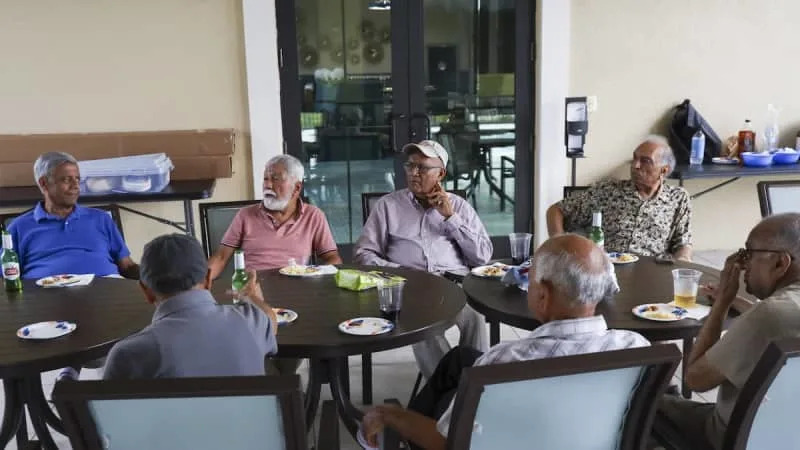
“We call him ‘young punk,’” Anil Shukla said, nudging Suresh Tijoriwal’s shoulder.
Tijoriwal laughed. The 74-year-old sat at the head of a table crowded with bottles of Stella Artois, paper plates of snacks and plastic cups of red wine. In the glass-walled portico, eight neighbors gathered for Wednesday evening happy hour, a tradition for nearly five years.
The men are from all over India: Mumbai, Shimla, Ahmedabad, Kolkata. They’ve spent decades raising families and building careers across the U.S. And now, they live at Anand Vihar, a 167-home community for Indian Americans over 55 in Wesley Chapel.
Many of Anand Vihar’s 300-plus residents were among the first to arrive in the U.S. after the 1965 Immigration and Nationality Act removed quotas favoring European immigrants. Between 1960 and 1980, the number of Indian immigrants living in the U.S. grew from about 12,000 to 206,000, according to the Migration Policy Institute. In 2023, that number was over 3.2 million.
About 43,000 Indian Americans lived in the Tampa Bay region as of the 2020 Census, making up less than 2% of the population across Hillsborough, Pinellas and Pasco counties.
But the Indian American community has grown much faster than each county’s overall population, according to estimates from the American Community Survey. The sharpest increase is in Pasco County, where Anand Vihar is located. The Indian American population more than doubled between 2015 and 2023, growing nearly six times faster than the county as a whole.
This first major wave of Indian immigrants is retiring in a country where few in their community have grown old. Just 13% of Indian immigrants in the U.S. are over 65. The median age is 41.As that population ages, questions about what growing old looks like in America take on new relevance.
In Anand Vihar’s central clubhouse, gold-framed paintings hang above jewel-toned armchairs. Stacks of themed art books sit beneath bronze sculptures. A rotating TV screen advertises upcoming prayers and dance nights. In the back, a domed panel opens to a pool, beyond which is a pond surrounded by a ring of villas.
Anand Vihar is among the first and most luxurious retirement communities for Indian immigrants in the U.S., offering comfort in the Florida sunshine and a sense of cultural familiarity.
Chefs craft meals with Ayurvedic balance in mind, a traditional Indian medicine system. Neighbors organize group walks and trips to national parks. If a health concern arises, the community’s some 25 retired doctors are just a knock away.
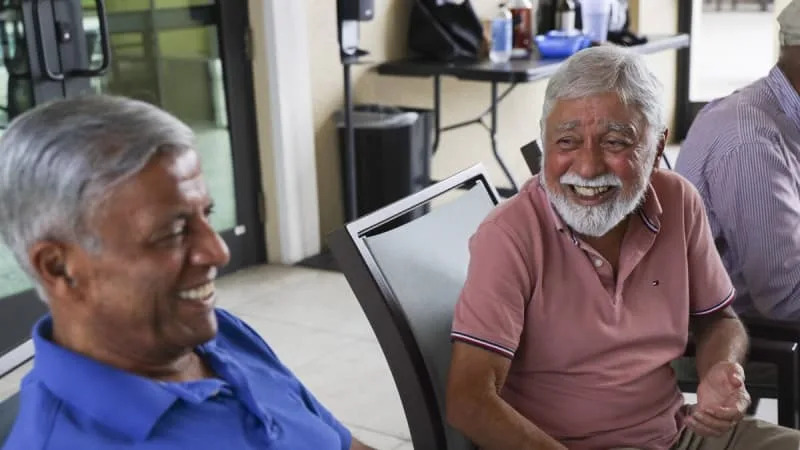
Tijoriwal immigrated to the U.S. from Kolkata in 1973 and moved to Anand Vihar four years ago. Before that, he spent 20 years in Michigan earning a master’s degree in industrial engineering and working at a computer center and 20 years in Winchester, Va., where he worked in management.
He and his wife felt their social life thinning. Friends moved closer to family, but his only daughter lived in New York City, which he said was too cold for him.
He and his wife toured several warm Florida communities, from large ones like The Villages, to Indian-focused developments like Nalanda Estates in Parrish.
Anand Vihar stood out for its beauty and vibrant social scene, he said. Since moving, Tijoriwal joined the volunteer board, plays the stock market and walks 15,000 steps a day.
“At this stage in our lives, it is important for us to be socially active,” he said. “Every day at the clubhouse, there’s ping pong, cards, pujas.”
Here, he and his wife found the active life they missed in Virginia. His daughter, a teacher, visits with his grandkids in the summer.
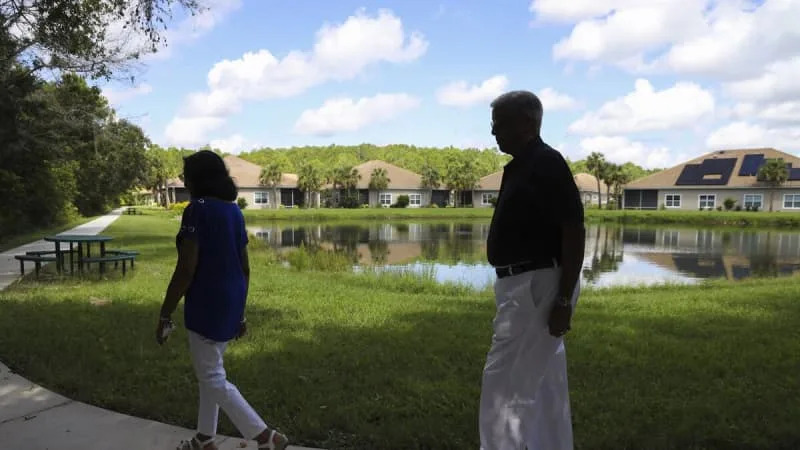
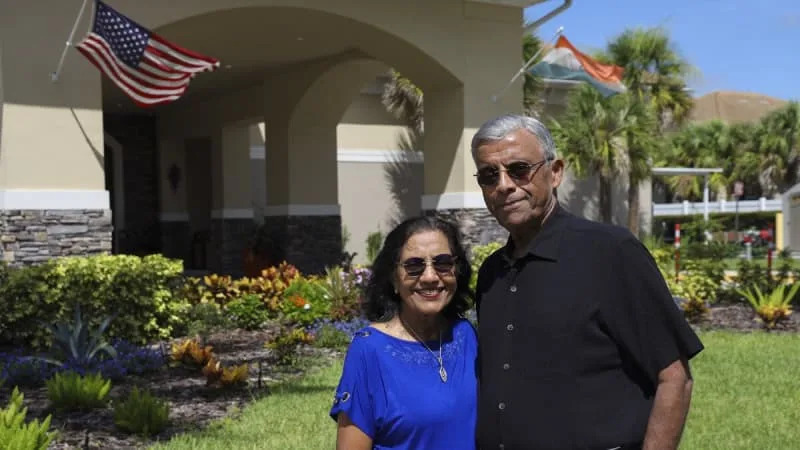
Santosh Govindaraju saw a gap in the national market for retirement communities catering to aging Indian immigrants. A Tampa native and a real estate developer, Govindaraju noticed niche retirement groups within faith-based communities, such as local synagogues, and wondered if he could create something more comprehensive. Though Anand Vihar is technically open to anyone, not limited to any one group or people.
Partnering with experts in real estate, construction and medicine, he set out to build Anand Vihar. The first villas went on sale in 2017. Homes range in price from $260,000 to $675,000. Within three years, the community sold out.
Beyond the sunny weather and a strong community, residents at Anand Vihar praise the food. With India’s culinary diversity, Govindaraju said he knew that food united Indians.
Soon after shaping the project, he brought on Mumbai-born chef Sunny Grewal, who trained at major international hotels in India before moving to the U.S. in 2016.
Govindaraju first visited Grewal’s South Indian restaurant, Godavari, in Tampa in 2019 and liked the food. The two discussedAnand Vihar and Grewal liked the idea of working with older adults to give back to his community.
They created a nutrition-focused menu inspired by Grewal’s time working at yoga retreats in India, where he learned the food practices of Ayurveda and its emphasis on freshly prepared food. Everything at Anand Vihar is prepped and cooked on the same day, Grewal said. For Hindu festivals like Pongal and Diwali and on Indian Independence Day, Grewal’s team prepares special dishes. Shrikhand Puri and Puran Pole, dishes from the Western Indian state of Gujarat, are favorites.
Around 80% of Anand Vihar residents have at least one meal a day in the clubhouse, said kitchen manager Stephanie Santiago. Some residents sit on a food committee that works with Grewal on menus.
Santiago has become a familiar face for residents, who thank her by name. Many women tell her that the kitchen gives them the freedom to go on trips and visit their kids, knowing their husbands won’t have to rely on them for meals.
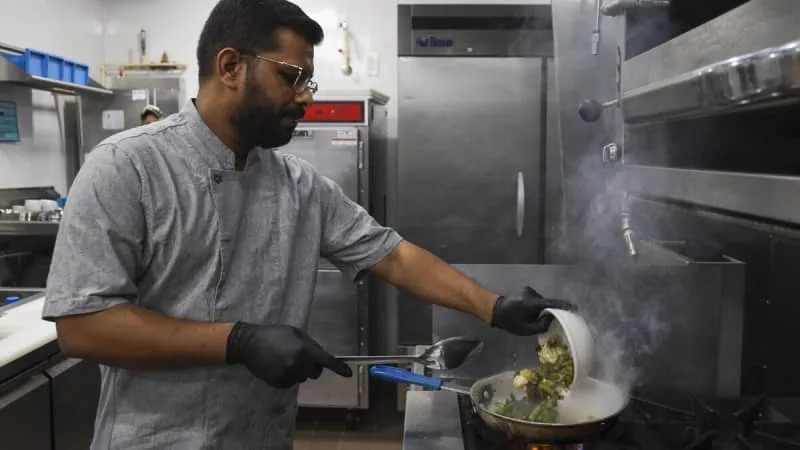
Roopa Shah and her friends are always first in line for food. They wait in the clubhouse, knowing it’s only seconds from the pickup orders rolling out to the buffet-style dining room opening.
Shah, 77, has lived at Anand Vihar for over five years. She came to the U.S. at age 20 and stayed until she was 50, mostly in New Jersey, before returning to India for 25 years to care for her mother. After her mother’s death, she returned to the U.S.
Her two children live in the U.S, but she never considered moving in with them.
“I don’t like to be a burden in any way,” she said. “I’d rather not live in the same city.”
Shah wanted her own space and a community where she wouldn’t feel alone. A visit to her sister at Orlando’s ShantiNiketan, known as the first U.S. retirement community for Indian immigrants, showed her the appeal of a cultural setting. Still, she hoped for something more luxurious.
Then she found Anand Vihar. She kept in touch with the developers until the villas were ready.
Her days start slowly. She lives alone, doing chores in her villa and cooking for herself. At 2 p.m., she meets residents in the clubhouse to play cards. She goes on group walks and joins friends for dinner.
“Being raised the same way shows up at this age,” she said. “Not language, but rather people understanding what you mean when you say it. Everyone being the same age, we have similar expectations from life.”
Her expectations are simple: “I want peace of mind,” she said. At Anand Vihar, she feels like she’s found it.
Redefining aging traditions
For most older Americans, a retirement community is the exception, not the rule, said Dawn Carr, a sociology professor who directs the Claude Pepper Center at Florida State University.
The first modern, age-restricted retirement communities, built around 1960 in Arizona, aimed to make healthy living easier. One part of that equation is food, and not just because of diet. Carr said communal meals are a way for people to congregate over shared traditions.
“The science of healthy aging says that meaningful relationships and engagements in activities and groups where you feel like you belong is important,” Carr said.
But she worries that age-segregated communities limit intergenerational connections that give people a sense of history and belonging.
In the 55-plus phase of life, people have great capacity for leadership, mentorship and change, she said. That’s why she values mixed-age communities. “Communities lose a lot if old people leave and aren’t there to be a part of the learning and growth.”
Affordability is another challenge. “You have to be wealthy enough to do it,” Carr said. “That’s an underlying requirement.”
For many Indian immigrants, retirement does not look like Anand Vihar.
Dr. Vasundhara Kalasapudi, a geriatric psychiatrist who runs India Home, a social service network for older Indian adults in New York City, said people often don’t believe poverty exists in Indian American communities.
But she sees it every day.
Many seniors she serves spent decades working low-wage jobs at grocery stores and small businesses and still struggle to make ends meet. Case managers are overwhelmed with requests for help with benefits and rent. Kalasapudi gets weekly calls asking about starting India Home in other cities.
There aren’t enough services to meet the need, she said.
For those who can afford it, Anand Vihar may be the start of a cultural retirement model for Indian immigrants. Vasudha Narayanan, a Hinduism professor at the University of Florida, said the “stigma to go to an old-age home” kept many in her parents’ generation from considering such a move. Now, she said, attitudes are shifting and people are embracing the idea of growing old together.
Many immigrants, she said, choose to stay in America, feeling less connected to India and wanting to stay close to their children. Narayanan believes the market for such communities will grow.
“As long as new immigrants come in, they’ll need a place that resembles India,” she said.
Narayanan and her husband, who also immigrated from India, have discussedretiring in the U.S. “When we were young, we left our parents and came here, and missed them growing up,” she said. “I don’t want to repeat that and move away from my kids now and miss out on both ends, on both generations.”
Developer Santosh Govindaraju saw that demand. Since Anand Vihar’s opening, he’s started a second site, Anand Nilay, about five miles away in Pebble Creek. Twenty homes have already sold and he expects completion in two years.
Finding a new sense of community
For the residents who plan Wednesday evening hangouts in their “happy hour” group chat, the rhythms of retirement look nothing like slowing down.
Just the other day, 80-year-old Anil Shukla took a neighbor to the doctor, helped a retired professor with his laptop and repaired another neighbor’s garage door.
Another time, a team effort saved a neighbor from a coma. Shukla woke retired doctor Pawan Gupta, who stabilized the patient while others rushed to direct emergency responders.
Some of their neighbors left the community to live with their children and later told friends they regretted it. Living with adult children who are busy with their own lives is isolating, they said. Here, there’s always someone to talk to or walk with.
***
Staff writer Riya Sharma is a 2025 Voices Fellow, through a student journalism program from the Asian American Journalists Association. This story was produced in partnership with AAJA as part of her fellowship. For more information, visit voices.aaja.org








Comments